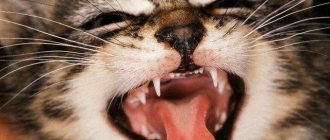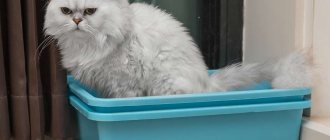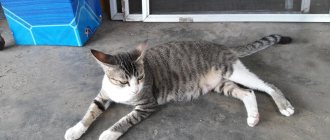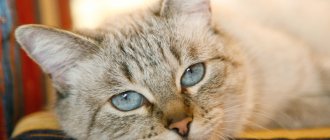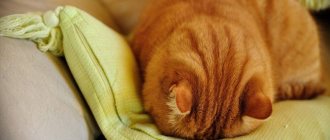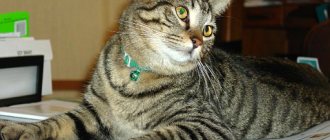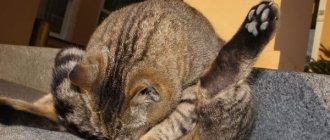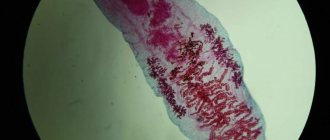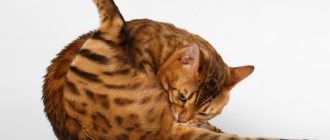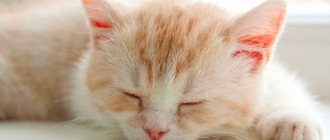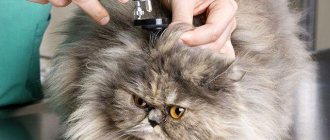Mastitis in a nursing cat poses a mortal danger not only for the sick cat, but also for the kittens. Owners engaged in breeding often encounter this problem. But pregnancy and lactation are not always the cause of mastitis - in rare cases, the disease affects untied and sterilized pets. Knowledge of the main symptoms will help to detect the disease at an early stage and begin its treatment in a timely manner.
Causes of mastitis in cats
global $ads_google; //data-ad-slot=”2475549904″ $ads_google = empty($ads_google) ? false : true; ?> if ($ads_google == false) {?>
$ads_google = true; ?> } ?>
Factors that initiate mammary gland pathology can be very different. They concern both the physiology of the animal itself and environmental conditions. The claim that mastitis only occurs in lactating cats and does not occur in cats that have been neutered is a misconception. Practice shows that mastitis occurs in cats in any condition. Precipitating conditions include:
- Injuries, mechanical irritation in the gland area.
- Infection of tissues through cracks in the nipples.
- Gynecological and urological diseases.
- Stagnation of milk due to early weaning of kittens from their mother.
- Blockage of the milk ducts for physiological reasons.
- Stillbirth of cubs in the same litter.
- Complications after cesarean section.
- Violation of hormone synthesis during estrus, false pregnancy.
The development of mastitis in cats is facilitated by hypothermia and a weakened immune system.
Causes of mastitis
The causes of the disease in females vary depending on the age of the animal and the physiological characteristics of the body. The pathology can develop in a sterilized, nulliparous or parous cat. The main causes include:
- diseases of the reproductive system of infectious etiology during pregnancy or after childbirth;
- hormonal imbalance that occurs against the background of a false pregnancy in the absence of fertilization;
- excess milk that arose against the background of stagnation;
- pathology that appeared during early weaning of kittens from the mother;
- injuries and bruises of a mechanical nature;
- sepsis, caused by the entry of fungi and other pathogenic microorganisms into the mammary glands through cracks in the nipples;
- hypothermia of the whole body or mammary glands;
- development of complications in the period after childbirth;
- inflammation of the suture after sterilization.
It is recommended to periodically inspect the milk lobes of females for cracks in the nipples. If there are injuries to the glands, wound healing compounds must be applied to them, which are purchased in specialized pharmacies after consultation with a veterinarian.
In a nulliparous cat
Mastitis in a nulliparous cat most often develops against the background of a false pregnancy. Hormonal disruptions occur during “empty” estrus, if ovulation has not occurred. The physiological causes of false pregnancy include swelling of the nipples - when you press on them, colostrum appears. If there are no newborn kittens and there is no one to suckle milk, the cat develops a serous form of the disease.
The female's temperature fluctuates, the animal loses its appetite. To prevent the development of other forms of the disease, it is necessary to take your cat to the veterinarian. An ultrasound specialist will refute or confirm the diagnosis and, if necessary, prescribe medication. To stop lactation, the female is given sedative medications.
After sterilization
Swelling of the milk lobes in a sterilized cat is characterized as a complication. During surgery, the veterinarian removes only the uterus, leaving the ovaries. In this case, the risk of mastopathy increases - fertilization of the female is impossible, but the ovaries continue to work as usual and produce hormones. The process affects the hormonal status, the animal’s body is in a stressful situation.
The suture after sterilization is located on the stomach. Lack of normal care and timely treatment of the suture increases the risk of developing inflammatory processes inside the scar. Infection in tissue can occur in several ways:
- Failure to comply with asepsis rules. During the rehabilitation period, the animal must be moved to a separate room. Bedding needs to be changed regularly; experts recommend using sterile disposable diapers for this purpose.
- Excessive cat activity. A female who constantly tries to lick and scratch the seam can cause an infection. In order to protect the cat, you need to put a special collar on it.
If the female has inflammation before sterilization, the risk of mastopathy increases.
After weaning kittens
If the kittens died immediately after birth or the cubs are severely weakened and are unable to suck milk on their own, the female’s mammary glands swell due to stagnation of milk. Lactostasis is accompanied by severe pain; the animal does not allow the owner to touch the nipples. In the absence of timely treatment, the milk lobes swell and acquire a bluish tint.
If milk does not come out naturally, then you need to purchase a special device - a breast pump. It can be used at the initial stage of the pathology - with a purulent, hemorrhagic or fibrous type, a breast pump will no longer help.
Forms and types of mastitis
The nature of the process depends on the symptoms and the type of pathogen. Mastitis in cats is classified into purulent, catarrhal, serous, fibrous, hemorrhagic, gangrenous. Each form is characterized by its own degree of severity, while one variety can transform into another.
Purulent mastitis
Pathogenic flora causes the accumulation of pus in the mammary cavities, which is released along with milk. With purulent mastitis, the presence of blood in the discharge is often noted. The mammary glands swell, turn red, and become noticeably hot and painful.
Further development of the disease causes general hyperthermia (a rise in temperature above normal), intoxication and depressed behavior. If pus appears in the milk, the kittens are separated from their mother to avoid poisoning.
Fibrinous
Changes in connective tissue provoke complete blockage of the milk ducts. There is an increase in lymph nodes, severe hyperemia and increased density of the mammary glands.
Any touch to them causes pain in the cat. With fibrous mastitis, intoxication of the body begins. Behavioral symptoms appear: the cat becomes lethargic and passive.
Serous
This type of mastitis in cats is characterized by general or partial redness of the integument and the release of a grayish secretion from the nipples.
If a female feeds kittens, the secreted milk acquires a thinner consistency, flaky impurities are noticeable in it, and an unpleasant odor is felt. The skin covering the glands thickens or swells. With serous mastitis, the mammary glands increase in size, and the cat indicates pain upon palpation.
global $ads_google; //data-ad-slot=”2475549904″ $ads_google = empty($ads_google) ? false : true; ?> if ($ads_google == false) {?> $ads_google = true; ?> } ?>
Catarrhal
With this form of the disease, blockage of the ducts is observed. This provokes stagnation of milk secretion in the glands and increased proliferation of pathogenic microorganisms. Milky discharge has a characteristic unpleasant odor. Clots in the form of flakes are noticeable in the milk. Symptoms of catarrhal mastitis resemble a picture of a serous form.
Hemorrhagic
Due to minor hemorrhages in the tissues of the glandular organ, blood enters the ducts and is excreted with milk. The milk-secreting organs swell and become painful. From the outside, hematomas are visually detected.
Symptoms of mastitis can affect one or more glands at the same time.
Gangrenous
If the inflammation is not treated, necrosis begins in the mammary glands. Local tissue rejection becomes general and gangrene begins. External symptoms of gangrenous mastitis are blue, purple, brown, black spots. Painful ulcers and bleeding appear on the affected areas.
Forms
There are many different principles for systematizing the disease. Depending on the nature of inflammation, the following forms are distinguished:
- serous;
- infiltrative;
- purulent;
- abscesses;
- gangrene;
- phlegmon.
The first 3 varieties represent stages of the sequential development of the disease. With abscess mastitis, the lesion is clearly localized and is represented by a cavity with a large accumulation of pus. The development of phlegmon of the mammary gland leads to the spread of inflammation not only to the tissues of the organ itself, but also to nearby ones. With prolonged absence of treatment or decreased immunity, a gangrenous form occurs (due to massive tissue necrosis). Fibrinous and hemorrhagic variants are also distinguished separately.
Mastitis in a cat in advanced form
Types of mastitis by localization:
- superficial (located closer to the skin, prone to breakouts and discharge of pus);
- intramammary (affects gland tissue);
- retromammary (develops when a purulent focus spreads beyond the mammary glands - into the retromammary tissue);
- panmastitis (deviation affects all components of the package).
Clinical manifestations vary significantly depending on the form and cause of the disease. Let's look at each in more detail.
Serous form
The main feature is hyperemia of one or more lobes of the mammary glands and the separation of opaque liquid from the nipples - exudate.
The serous form is the initial form of mastitis
The following symptoms may also be recorded:
- the package where the focus is localized increases significantly in size. The skin over it is dense or doughy in consistency and significantly painful;
- the affected area and adjacent formations are hot to the touch;
- The milk that is released from the nipple of the affected gland eventually acquires a thinner consistency and an unpleasant odor. After 2-4 days from the onset of the disease, small flocculent inclusions (casts of destroyed duct epithelium) can be detected in the milk;
- increase in general body temperature. This feature may not always occur and depends on the reactivity of the cat’s body and the pathogenicity of the pathogen.
The disease can involve either one package or be widespread, involving all breast tissue.
Catarrhal mastitis
This form affects exclusively glandular tissue. Clinical manifestations do not differ from the serous form, but are characterized by the formation of a large number of flakes that can clog the gland ducts, leading to additional stagnation of milk and its infection.
Mastitis is a fairly common disease in cats.
The pet usually feels well. There may be no symptoms at all; they appear a few days later due to stagnation of milk.
Fibrinous form
When the ducts are completely blocked, milk remains in the gland for a long time in the absence of its secretion, as well as refusal of therapy lead to complications, one of which is fibrinous mastitis. Distinctive features:
- significant increase in body temperature.
- intoxication. The cat first shows maximum activity, then lies down, practically motionless.
- an increase in size (2 or more times) of the nearest lymph nodes.
- the bags are painful, dense to the touch and enlarged.
- When palpated, multiple crepitations are heard - crunching sounds.
Changes in the appearance of the gland with fibrinous mastitis
Purulent inflammation of the glands
The purulent form is always accompanied by a decrease or complete disappearance of lactation. The package is enlarged, sharply swollen, and hot to the touch. The skin around the nipple is hyperemic (reddened). Large volumes of pus mixed with blood may be discharged from the nipple. The area where the abscess is located is dense and sharply painful, and the surrounding tissues (within a radius of up to 3-5 centimeters) have a soft doughy consistency.
After a few days, local symptoms are joined by general ones. The temperature rises significantly and intoxication increases. The cat does not show activity, prevents contact with people and kittens, and tries to retire.
The pathology becomes chronic in 85% of cases. Exacerbations can be recorded due to childbirth, hypothermia, and traumatic effects on breast tissue. The abscess cavity does not disappear, but is overgrown with connective tissue. If the abscess is significant in size, the mammary gland will never be able to show functional activity (produce milk).
The purulent form in 85% of cases becomes chronic
Attention! Purulent mastitis is dangerous not only for the cat itself, but also for the cubs, since pus can be released with milk, containing many pathogenic microorganisms.
Hemorrhagic mastitis
This type is the most dangerous phenomenon. The breast tissue, all the ducts, the alveolus with the papilla are covered with numerous hemorrhages and have all the signs of a serous inflammatory process. The tissues are extremely swollen and soaked in blood, the glands are painful. The general condition of the pet is depressed. In 15% of cases, bleeding may occur due to disruption of the integrity of blood vessels and changes in the aggregation properties of blood. It can be suspected if there are accumulations of blood on the cat’s body or brown spots in its permanent habitat.
Video - Mastitis in animals
Gangrenous and phlegmonous types of mastitis
With weak immunity, against the backdrop of a long-term lack of treatment, and in poor sanitary conditions, the animal experiences necrosis of the mammary gland tissues affected by inflammation. They take on a bluish or dark brown tint. Ulcers may form on affected areas with periodic bleeding and shedding of dead tissue.
It is extremely rare that the cause of gangrene is phlegmon - a diffuse focus of purulent lesion that melts all tissues, mainly fat and connective tissue.
Against the background of such changes, the cat’s condition deteriorates sharply. She is practically motionless and there may be no consciousness. Body temperature rises to prohibitive numbers (41 degrees and above) or drops significantly. In the absence of treatment (including surgery), as a rule, the animal dies.
Gangrenous mastitis
Methods for diagnosing mastitis
The very beginning of the disease may be missed due to a blurred clinical picture. Further development contributes to a more pronounced manifestation of symptoms. Diagnosis of mastitis in a cat consists of visual examination, palpation, ultrasound and laboratory tests. After which treatment is prescribed.
Blood is taken from the animal to determine the total number of cells and hemoglobin. To determine the degree of inflammation and the pathogen, an analysis of discharge from the mammary gland is performed. This cytological study also helps to determine the nature of inflammation. A high number of dead epithelial cells indicates the fibrous, catarrhal, serous type. An increased number of red blood cells and platelets diagnoses the hemorrhagic form.
The ultrasound method helps determine the localization of the pathogenic process, the condition of the ducts and the presence of fluid in them. Ultrasound checks the condition of the glandular cavities and the tissues of the glands themselves. Diagnostics makes it possible to distinguish mastitis from less dangerous mastopathy, adenoma, and benign growth of glandular tissue.
Diagnosis of the disease
If symptoms of mastitis are detected, the cat should be taken to the veterinarian. The doctor can easily determine the presence of an inflammatory process by palpation. In addition to visual inspection, other methods are used for diagnosis:
- a general blood test that will show an increase in the level of leukocytes and a decrease in the number of platelets;
- Ultrasound - with the help of this study it will be possible to determine where exactly the source of inflammation is located, which parts of the mammary gland are inflamed;
- bacteriological examination of milk is necessary to determine the type of pathogen;
- Cytological analysis allows you to examine breast cells.
Why is mastitis dangerous?
global $ads_google; //data-ad-slot=”2475549904″ $ads_google = empty($ads_google) ? false : true; ?> if ($ads_google == false) {?>
$ads_google = true; ?> } ?>
Purulent inflammation of the mammary glands threatens to spread to other organs without treatment and result in general sepsis. Such a serious condition is fraught not only with intoxication, but also with the death of the animal. Kittens suffer no less, receiving, at best, defective milk, and at worst, poisoned milk. The death of babies due to purulent mastitis in cats often happens.
An advanced form may require the help of a surgeon
Advanced mastitis often develops into a chronic form. In case of hypothermia or weakened immunity, the cat’s glands begin to become inflamed. The cavities that were previously filled with pus are overgrown with connective tissue. The mammary gland loses its ability to function normally. Another danger is the possible degeneration of glandular tissue. This is how tumors of both benign and malignant nature appear.
Complications
It should be noted that complications of mastitis in animals are extremely rare. Among them are:
- spread of inflammation to neighboring organs and tissues;
- hematogenous dissemination of microorganisms (the heart and brain are most often affected);
- sepsis – the presence of multiple purulent foci throughout the body;
- infectious-toxic or painful shock;
- transformation of the mammary glands with the development of malignant and benign tumors;
- death of an animal from any of the above factors.
Mastitis must be treated
Treatment of mastitis
Conservative therapy uses antibiotics and immunocorrective medications. In more severe cases, surgical intervention is resorted to. The duration of treatment for mastitis in a cat is determined by the form of the disease:
- serous - 5-7 days;
- fibrinous - 5-10 days;
- purulent - 14 days;
- gangrenous - 25-30 days;
- hemorrhagic - 10-15 days.
Antibacterial treatment includes cephalosporins (Cefazolin, Cephalexin) or penicillins (Amikacin, Ampicillin). If a fungal infection is added to a bacterial infection, the patient is treated in parallel with antifungal drugs: Griseofulvin, Amphotericin.
When the inflammatory process goes too far, the cat is operated on: the abscessing boils are opened, the purulent contents are removed, and the cavities of the milky lobes are cleaned. In some cases, a partial or complete mastectomy (removal of the breast) is indicated. After surgery, the animal requires a long rehabilitation period.
Anesthesia
If the pain syndrome is severe, the cat is given a novocaine blockade before starting treatment. To do this, an injection is made into the fat layer between the affected area and the peritoneum with a 0.5% or 1% solution of novocaine. The dose depends on the weight of the pet: for every kilogram of weight, take 1 ml of the drug. At the same time, an antibiotic is added to the syringe. Anesthesia is repeated at intervals of two days until the pain symptom completely disappears.
Strengthening the immune system
To strengthen the body's defenses, the cat is prescribed complex dietary supplements. Vitamins and minerals support the immune system and help quickly neutralize the inflammatory focus. The vitamin preparation is fed to the animal for two months. Immunomodulators also provide support: Neoferon, Globfel, Catozal and others. The immunoglobulins and plant extracts they contain stimulate your own immunity.
Treatment of congestive form
If stagnation of milk is noted, it is necessary to carry out procedures to stimulate its outflow. Diuretics are prescribed among medications. They promote faster removal of fluid from the body, thereby slightly reducing the flow of water into the mammary glands.
global $ads_google; //data-ad-slot=”2475549904″ $ads_google = empty($ads_google) ? false : true; ?> if ($ads_google == false) {?>
$ads_google = true; ?> } ?>
Treatment of stagnant mastitis includes antiseptic compresses made from Chlorhexidine. The solution is heated to body temperature, a sterile gauze cloth is moistened in it, lightly squeezed and applied to the sore spot. Cover the compress with polyethylene and bandage it. Keep the bandage on for 10-15 minutes. An alternative to Chlorhexidine can be ichthyol or chloramphenicol ointment, infusions of medicinal herbs with an antibacterial effect.
What is mastitis
Mastitis is an inflammation of the mammary gland that occurs in all mammals, including cats.
Mastitis, mastopathy and breast tumors are completely different diseases that require different approaches to treatment.
Mastitis in most cases is caused by bacterial flora, especially pyogenic staphylococci and streptococci, as well as their associations with other types of bacteria. Less commonly, the cause of pathology may be fungal flora.
Mastitis is usually divided into:
- Lactation. They occur during the active functioning of the gland and are associated with milk production. They are characterized by the rapid development of the infectious process with the involvement of new areas, and there is also a risk of generalization and the development of septic complications. This is due to the fact that during lactation the mammary gland has a large number of natural cavities filled with milk and surrounded by fatty tissue, this is an attractive substrate for bacteria. An extensive network of milk ducts, as well as lymphatic vessels, creates good conditions for the rapid spread of microbial flora. The occurrence of lactation mastitis is preceded by lactostasis - with insufficient or untimely emptying of the gland, an increase in the number of microbial flora occurs, which is normally washed out of the ducts. Bacteria cause fermentation, as a result of which the milk curdles and the epithelium of the excretory ducts of the gland is damaged. Curdled milk and desquamated epithelium form clots that block the milk ducts, impede the outflow of milk and create favorable conditions for the development of mastitis. In parallel with the proliferation of microbes, stagnation begins in the lymphatic vessels and veins, since their thin walls are compressed by increasing edema, which further contributes to the development of infection. The lactation form of mastitis is the most common.
- Non-lactational. They develop as complications of a gland injury or a pustular skin infection against the background of an immunodeficiency state. In this case, the glandular tissue is involved in the inflammatory process for the second time, being affected by an infection that has spread from adjacent areas. The course of non-lactation mastitis is less violent, but they predispose to the occurrence of mastitis during lactation both due to changes in the anatomical structure of the gland, and due to the possible preservation of areas of inflammation and microbial flora in its tissues and ducts.
Mastitis most often affects nursing cats.
Treating cat mastitis at home
Complicated types of mastitis in cats require the help of a veterinarian. You can treat a sick pet at home only with catarrhal or serous mastitis. The owner has the power to alleviate the animal’s condition and speed up the treatment of mastitis. To do this, it is permissible to use a light stroking massage. If touching causes pain or discomfort in the cat, tactile stimulation is abandoned. Rubbing with ichthyol or camphor oil helps. The product is applied after the massage. The smeared surface is covered with film and bandaged.
When the mammary glands of a nursing cat become overfilled and tense, they resort to expressing milk. To limit secretion production, reduce the amount of water in the bowl. It is advisable to switch the cat to dry food and give water only when feeding.
The most important thing when treating mastitis in a cat is to follow all the instructions prescribed by the doctor.
When it is impossible to treat
The cat owner should recognize symptoms that indicate the inadmissibility of self-treatment at home. If at least one of them appears, you should urgently seek help from a specialist. This list includes:
- soreness and severe hardening of the glands;
- enlargement of nearby lymph nodes;
- cloudy discharge from the nipples with traces of pus and blood;
- fever, fever.
Severe disease requires medical intervention. Treatment of mastitis in such cases consists of a complex of analgesic, antibacterial, and immunomodulatory medications.
Folk remedies
It is useful for a sick cat to apply warm compresses to the area of the affected organ. Decoctions or infusions of chamomile, oak bark, sage, string, and birch leaves are used as a medicinal liquid. To prepare the drug, one tablespoon of herb or collection is poured with boiling water and infused. After filtering, a piece of gauze is moistened in the solution and applied to the sore spot. Place polyethylene on top and lightly bandage it. The procedure lasts 20-30 minutes and is repeated up to five times a day. Cabbage leaves used to treat mastitis do not have noticeable effectiveness, so they are used only for very mild forms of mastopathy.
Prevention
Mastitis is a disease that can be easily prevented if the following conditions are met:
- rationing the diet, as well as the qualitative and quantitative composition of food. Adding a large number of mineral supplements, cottage cheese and dairy products to food leads to increased milk secretion;
- control of fluid intake. With a small number of cubs, the volume of water per day should not exceed 110-115% of the volume that the cat drank before giving birth;
- conducting regular examinations by a veterinarian (at least once a year) in order to identify helminthic infestations, focal injuries and lesions of the mammary glands, fleas and other parasites, which can not only reduce the activity of immunological protective barriers, but also lead to the development of mastitis;
- control of alternate use of all mother's nipples by kittens. This is especially important with small litters;
- compliance with hygiene rules. The cat needs to be in satisfactory living conditions. Her household items must always be clean and promptly subject to washing and other methods of removing contaminants. If there are cracks and scratches on the skin of the papillae (very often they occur on thin skin), it is necessary to carry out treatment (hydrogen peroxide, chlorhexidine) to destroy all bacteria. When interacting with a cat, it is recommended to wash your hands and remove dirty shoes;
- Carrying out manicure events for kittens. Large and sharp claws claw the skin and soft tissues of the mother.
During treatment, it is necessary to isolate kittens from the cat.
How to express milk to a cat
To express milk from a lactating female, it is recommended to use a special breast pump. If the device is not available, it is easy to make it yourself. To do this, take a plastic disposable 5 ml syringe. The piston is removed from it and the top is evenly cut off along with the nose, which is intended for the needle. Next, the cut is melted over fire. Allow the plastic to cool slightly and smooth out the edge with your fingers so that it is smooth and without sharp protrusions. Put the piston in place.
To express milk, the device is applied to the skin so that the nipple is in the center of the cut out circle. When the piston is raised, a vacuum is created in the breast pump and milk flows into the container. It is enough to do this procedure once a day. The entire process of making the device and pumping is clearly shown in the video:
Before using a pumping device, you need to make sure that your cat does not have a blocked milk duct!
Symptoms
Many owners may not immediately notice the symptoms of mastitis in their cat. It's not that they're barely visible.
The reason lies in the fact that it is rare that a pregnant or giving birth cat will allow it to approach its nipples. She won't let you touch her belly.
This is why the initial stage of mastitis usually goes unnoticed.
So, the main signs of mastitis in a cat:
Inflammation of the gland
When the mammary glands become inflamed, the nipples become swollen, red, and hot. When you touch them, the animal experiences a strong pain reaction. The mammary glands are hard and the skin is cracking. Due to the fact that the outflow of milk is difficult (due to inflammation, the milk ducts decrease in diameter, and the milk curdles and becomes “thick”), the cat’s “breasts” become hard. The skin on the nipples may crack due to strong tension, because the gland swells.
General reaction of the body
In addition to the mammary glands, the entire body also reacts. Fever (high temperature) begins, appetite practically disappears, lethargy. A cat may avoid kittens because they are drawn to the nipples, causing extreme pain to the animal. In addition, such “purulent” milk should not be consumed by newborn kittens.
How to feed kittens with mastitis in a cat
If a nursing cat has been diagnosed with inflammation, then the method of feeding the kittens directly depends on the severity of the disease. If one or two mammary glands are mildly affected, they are bandaged or sealed to limit the babies' access to the affected nipple. If the inflammation has affected all the glands or mastitis develops according to the purulent, hemorrhagic, gangrenous type, then the babies should be isolated from the mother. Milk containing toxic substances can cause poisoning in young kittens.
When is an urgent need to contact a veterinarian?
Unfortunately, it is not always possible to catch mastitis at an early stage, and in the vast majority of cases this is due to the rapid development of the inflammatory process, as well as the fact that many nursing cats do not allow examination of their abdomen and mammary glands.
An urgent visit to the clinic is necessary if:
- increased cat body temperature;
- signs of intoxication appear: lethargy;
- thirst;
- lack of appetite;
- general oppression, apathy;
- is a surgical pathology;
If the cat’s temperature rises and the cat’s well-being becomes unwell, self-medication is unacceptable.
Prevention of mastitis
global $ads_google; //data-ad-slot=”2475549904″ $ads_google = empty($ads_google) ? false : true; ?> if ($ads_google == false) {?>
$ads_google = true; ?> } ?>
The risk of mastitis in a cat can be reduced if you remember the rules of prevention. First, you need to regularly examine your pet's belly. It is especially important to pay attention to the cat during pregnancy and lactation. Cracks, wounds from kittens’ claws and teeth, and dry areas of skin need to be treated in a timely manner. If any suspicious signs appear, you should consult your doctor.
Treatment at an early stage of the disease is much easier and faster.
Secondly, your furry pet should be protected from drafts, hypothermia, and contact with sick relatives. Thirdly, the animal must undergo deworming and treatment for ectoparasites on a schedule. Fourthly, it is recommended to monitor the quality of food and quantity of water. This is especially true for a nursing cat. If there are one or two kittens in the litter, it is necessary to control the lactation process so that there is no stagnation of milk. It has been noted that sterilized animals are less likely to experience inflammation of the mammary organs. Therefore, veterinarians recommend sterilization if offspring are not planned.
With proper care and attention to the cat, it is quite possible to prevent the onset of the inflammatory process in the mammary glands in time. Adequate treatment prescribed by a veterinarian and care at home will help restore your pet’s health. In this case, already born and future babies will be provided with full-fledged mother's milk.
Disease prevention
Preventive measures help prevent the development of mastopathy. Pregnant and lactating females should be given less foods containing carbohydrates. A balanced diet must be agreed upon in advance with your veterinarian. Before mating, both the cat and the cat must be treated for fleas and intestinal parasites. Kittens sucking milk must be shifted from one nipple to another - this will ensure an even release of milk.
A lactating, nulliparous or sterilized female needs to change the bedding on time, wash water bowls and dishes. This will help to comply with sanitary and hygienic standards. To avoid stagnation, a nursing cat is given a massage daily.
When self-medication is unacceptable
Fibrinous mastitis | Purulent mastitis |
|
|
Abscess mastitis | Hemorrhagic mastitis |
|
|
What does a doctor do
Subcutaneously or intramuscularly gamavit (0.3-0.5 ml/kg body weight once a day for up to 1 week) or catozal 10% (0.5-2.5 ml/animal once a day for 3-5 days ).- Subcutaneously or into the muscle, traumatin (0.1 ml/kg 1-2 times/day for a course of 1-5 days) or mastomethrin (0.5-2 ml/animal 1-2 times/day until signs of the disease disappear or for a course of up to 2 -x weeks).
- Novocaine blockade - 0.5% or 1% novocaine is administered between the abdominal cavity and the affected lobe of the mammary gland in a volume of 1 ml/kg with the addition of bicillin 5 or penicillin (10 thousand units/kg). Three injections are given, with a gap of 2 days between them.
- General antibiotic therapy with broad-spectrum drugs is mandatory: intramuscular cefazolin (20-25 mg/kg three times a day (every 8 hours) for 5 days), cephalexin (10-30 mg/kg twice a day for 5 days) or other antibiotics cephalosporin series.
- In particularly advanced cases, surgical intervention is required: opening or removing purulent abscesses, pumping out pus, stripping the affected tissues inside the diseased lobes, removing the affected parts or the entire mammary gland (mastectomy). You cannot do without a postoperative recovery period.
Treatment of inflammation of the mammary glands
If the owner is faced with such an unpleasant disease in his pet, he needs to know how to treat mastitis in a cat.
It will not be possible to cure mastitis in a pet, much less advanced (see photo), without injections. Injections and ointment are required. Catosal and calcium gluconate are usually prescribed. Injections to a cat who has given birth are often used to prevent mastitis with the drug Mastomethrin. They are injected into the hind leg or withers within a week after birth. The affected areas need to be lubricated with a special product. You can make your own ointment for cats against mastitis by mixing two ingredients: troxevasin and camphor oil in equal proportions.
Injections of traumatin, which is an antiseptic, are also recommended. Treatment of mastitis in cats with this drug is carried out by injection twice a day. If mastitis is advanced, then you cannot do without antibiotics. Such injections are prescribed by a doctor. Sometimes, treating nursing cats for mastitis may even require surgery.
All appointments must be agreed with a veterinarian so as not to aggravate the situation. Remember that this is a very insidious disease, and if not treated correctly, the pet may die.
